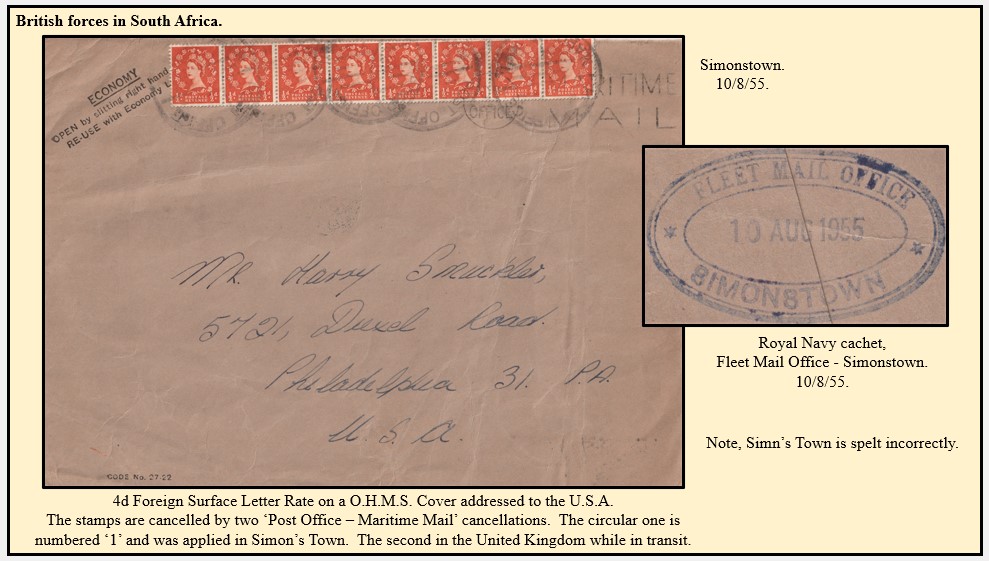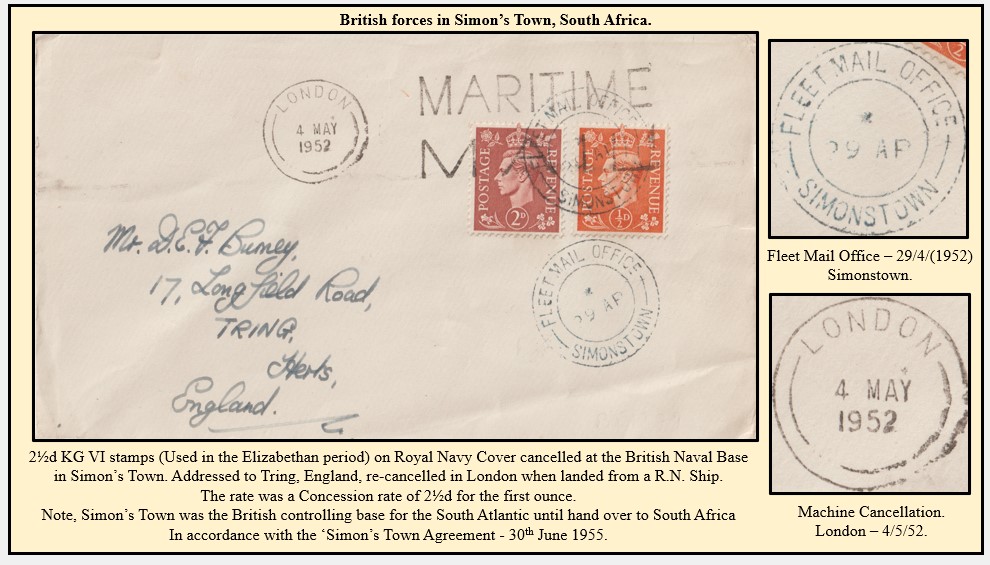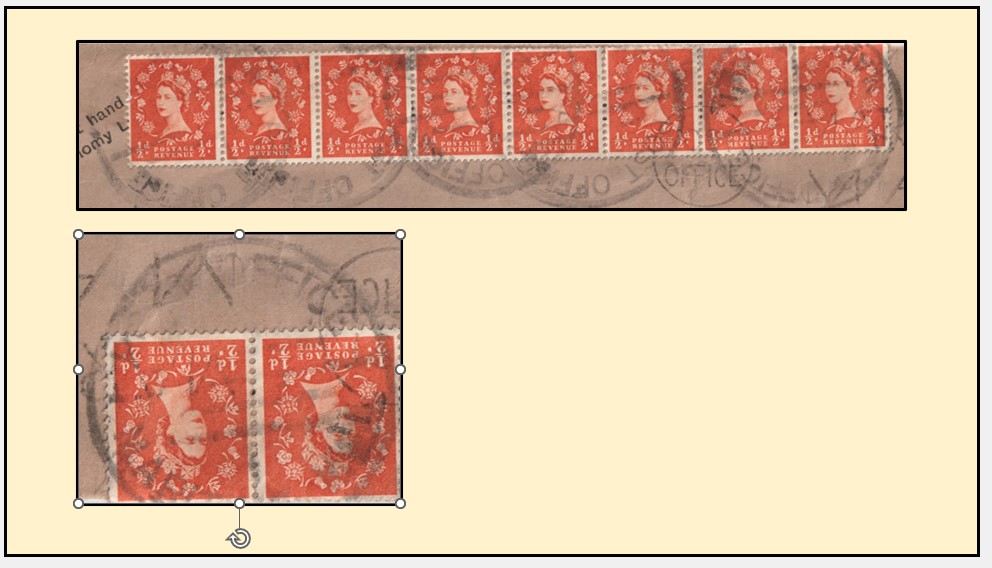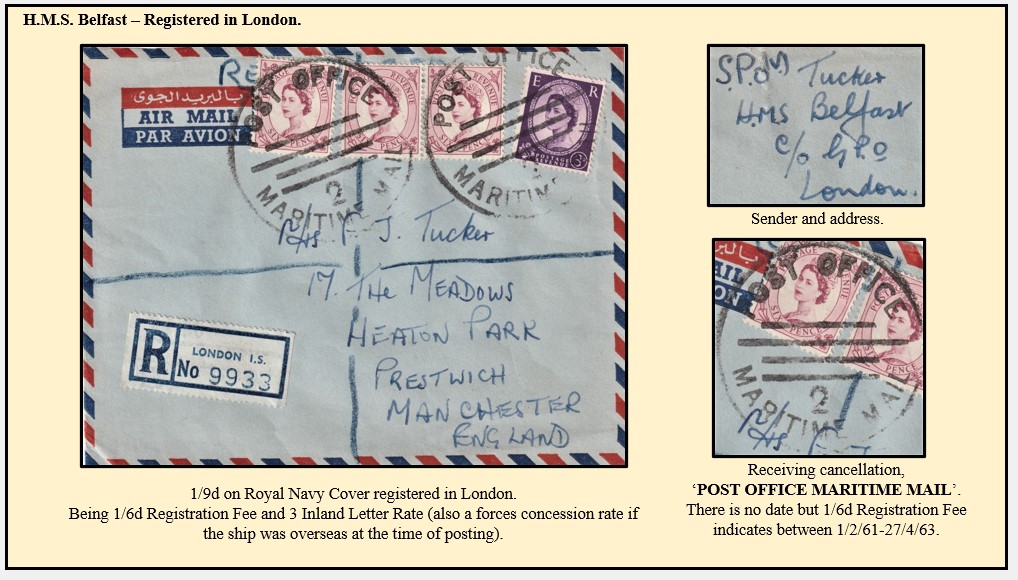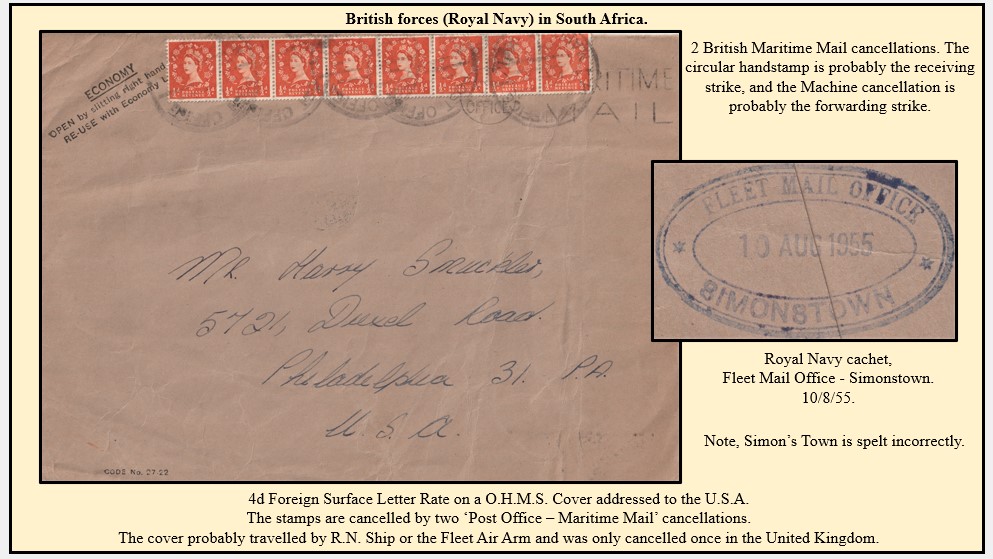Royal Navy - Simon's Town.
Quote from Steve on July 15, 2025, 11:38 amVery nice! I have a small collection of Simonstown. ('Simonstown' or 'Simon's Town'? Today the town attempts to use the latter. Both were used at the same and or different times and both were / are historically correct. My earliest covers state 'SIMONS BAY'. It is only in recent years that the Simons Town Historic Society and others have attempted to make 'SIMON'S TOWN' the correct name.)
The first two covers (which appear to be the same) show the 'PO MARITIME MAIL' machine cancellation. While the cover undoubtedly originated in the ROYAL OBSERVATORY, Cape Town, the 'PO MARITIME MAIL' mark was applied on arrival in the UK. I have tried to find proof that it was used in Simonstown but so far have not found any. (I have had better luck with' Tombstones'!)
I am intrigued by the third cover which undoubtedly originated in SIMONSTOWN. This can be seen from the 'FLEET MAIL OFFICE SIMONSTOWN' cachet. I am unaware of a circular 'PO MARITIME MAIL' cancelller numbered '1' that was used in Simonstown.
Regarding the bottom cover, this is cancelled according to the custom of the time with the 'FLEET MAIL OFFICE SIMONSTOWN' datestamp with the missing Year and received in the UK with the 'PO MARITIME MAIL' mark . I have two variations of the FLEET MAIL OFFICE SIMONSTOWN' datestamp , one without the Year. Your cover without YEAR is very nice because the LONDON receiver tells us that the year is 1952. One is not often able to associate a YEAR with these. I do not have such. I am envious.
Finally, I doubt that all of Simonstown's RN or Fleet mail travelled to GB on RN ships. I have no proof but my guess is that they would have used the weekly Mailboat service when there was an inconvenient gap in RN Ship departures from Simonstown to GB.
All-in-all, very nice. I can add a few pieces here if you like.
Very nice! I have a small collection of Simonstown. ('Simonstown' or 'Simon's Town'? Today the town attempts to use the latter. Both were used at the same and or different times and both were / are historically correct. My earliest covers state 'SIMONS BAY'. It is only in recent years that the Simons Town Historic Society and others have attempted to make 'SIMON'S TOWN' the correct name.)
The first two covers (which appear to be the same) show the 'PO MARITIME MAIL' machine cancellation. While the cover undoubtedly originated in the ROYAL OBSERVATORY, Cape Town, the 'PO MARITIME MAIL' mark was applied on arrival in the UK. I have tried to find proof that it was used in Simonstown but so far have not found any. (I have had better luck with' Tombstones'!)
I am intrigued by the third cover which undoubtedly originated in SIMONSTOWN. This can be seen from the 'FLEET MAIL OFFICE SIMONSTOWN' cachet. I am unaware of a circular 'PO MARITIME MAIL' cancelller numbered '1' that was used in Simonstown.
Regarding the bottom cover, this is cancelled according to the custom of the time with the 'FLEET MAIL OFFICE SIMONSTOWN' datestamp with the missing Year and received in the UK with the 'PO MARITIME MAIL' mark . I have two variations of the FLEET MAIL OFFICE SIMONSTOWN' datestamp , one without the Year. Your cover without YEAR is very nice because the LONDON receiver tells us that the year is 1952. One is not often able to associate a YEAR with these. I do not have such. I am envious.
Finally, I doubt that all of Simonstown's RN or Fleet mail travelled to GB on RN ships. I have no proof but my guess is that they would have used the weekly Mailboat service when there was an inconvenient gap in RN Ship departures from Simonstown to GB.
All-in-all, very nice. I can add a few pieces here if you like.
Quote from Jamie Smith on July 15, 2025, 5:09 pmThe two covers were the same and I have removed one. The cachet you mention; I have always taken it as a naval marking but on your observation, I have checked and find it is not recorded as such. But I do have other similar markings with a different number. Does anyone else have an observation on it? On this cover, to me, it appears to be cancelled at source as it is dated the same as the cachet, indicating Simon's Town. Thanks for observations.
The two covers were the same and I have removed one. The cachet you mention; I have always taken it as a naval marking but on your observation, I have checked and find it is not recorded as such. But I do have other similar markings with a different number. Does anyone else have an observation on it? On this cover, to me, it appears to be cancelled at source as it is dated the same as the cachet, indicating Simon's Town. Thanks for observations.
Quote from Steve on July 16, 2025, 11:31 amMy problem is that I cannot read the circular postmark with the '1'. If you can send me a hi-res image of the strip of eight stamps only, say 600 dpi, I will try to extract the postmark for further evaluation and discussion.
You have shamed me into starting a Simonstown post. You will see the start of it soon in a separate post. Here is a taster of the Simonstown we are discussing. The image below is part of one was painted in 1838 by C. Webb-Smith. The British started using the SIMONS TOWN Crown-in-Circle canceller in 1817, some 21 years before this was painted. Little has changed. It is a lovely sunny day with a gentle breeze. In the centre of the image you can see the Martello Tower on the far side of Simon's Bay. This area will become the Simonstown Naval Dockyard.
Christopher Webb Smith was a British artist working at the Cape of Good Hope between 1837-1839.
Inset is the first British postmark used in Simon Town in 1817.This is hard work. I need a smoke break - and a tot of rum!
HMS Terrible's Captain had a profound influence on the course of the South African War....
... but that's another story for another time.Finally, you can see the Earliest and Last Recorded uses of the Simonstown Hooded Circular datestamp as shown above if you click on the link to our study of this datestamp.
My problem is that I cannot read the circular postmark with the '1'. If you can send me a hi-res image of the strip of eight stamps only, say 600 dpi, I will try to extract the postmark for further evaluation and discussion.
You have shamed me into starting a Simonstown post. You will see the start of it soon in a separate post. Here is a taster of the Simonstown we are discussing. The image below is part of one was painted in 1838 by C. Webb-Smith. The British started using the SIMONS TOWN Crown-in-Circle canceller in 1817, some 21 years before this was painted. Little has changed. It is a lovely sunny day with a gentle breeze. In the centre of the image you can see the Martello Tower on the far side of Simon's Bay. This area will become the Simonstown Naval Dockyard.
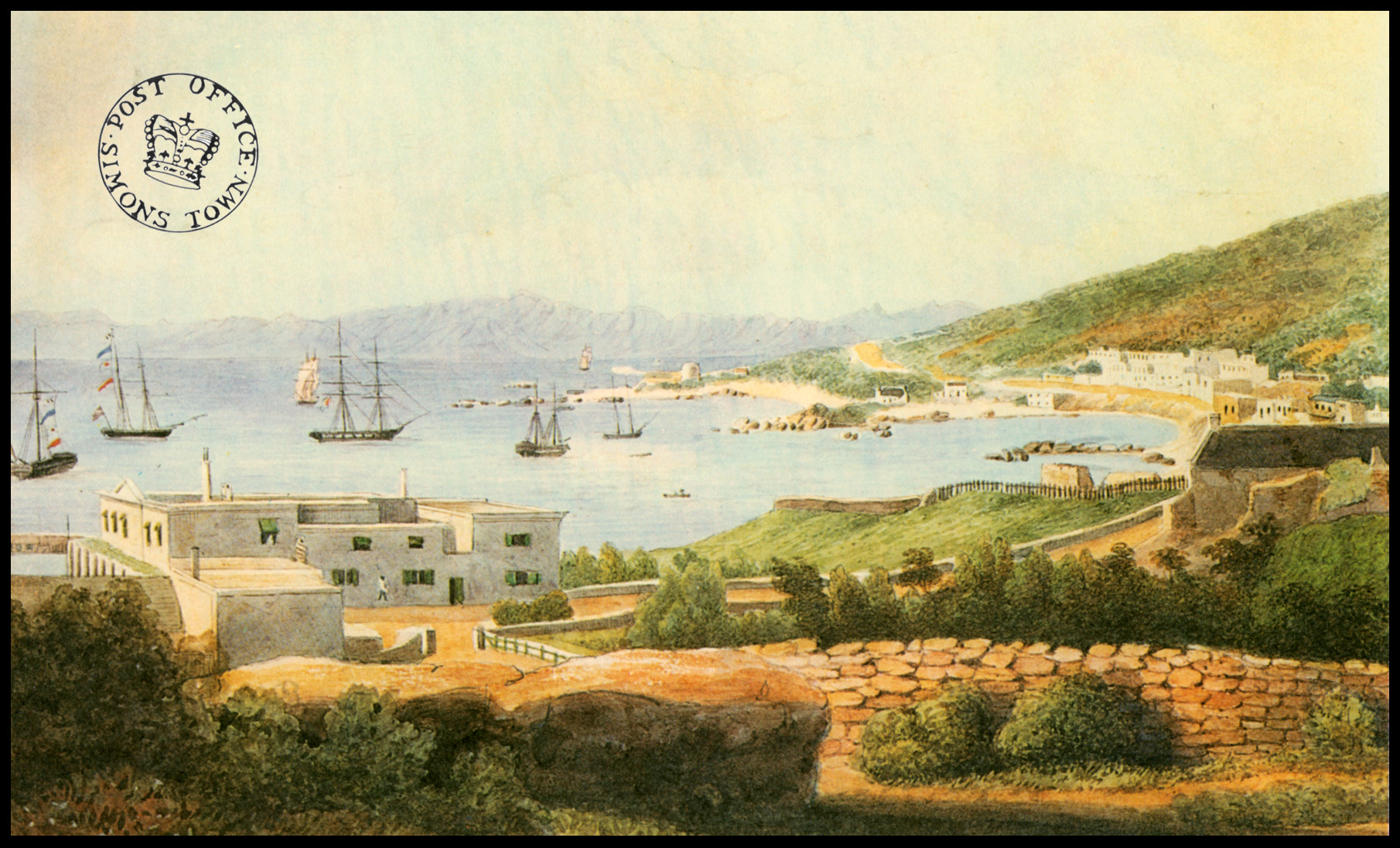
Christopher Webb Smith was a British artist working at the Cape of Good Hope between 1837-1839.
Inset is the first British postmark used in Simon Town in 1817.
This is hard work. I need a smoke break - and a tot of rum!

HMS Terrible's Captain had a profound influence on the course of the South African War....
... but that's another story for another time.
Finally, you can see the Earliest and Last Recorded uses of the Simonstown Hooded Circular datestamp as shown above if you click on the link to our study of this datestamp.
Quote from Jamie Smith on July 16, 2025, 12:21 pmI have done as requested and added a second cover from Belfast with the same type of cancellation. I realize it may be a post office cancellation but the date coincides with the cachet date and I do not think it could have reached UK in the time, that is the same day. This left me to believe it was cancelled at Simon's Town!
I have done as requested and added a second cover from Belfast with the same type of cancellation. I realize it may be a post office cancellation but the date coincides with the cachet date and I do not think it could have reached UK in the time, that is the same day. This left me to believe it was cancelled at Simon's Town!
Uploaded files:Quote from Jamie Smith on July 16, 2025, 12:43 pmThe penny has just dropped! I think it is a naval strike that was applied aboard a ship in Simon's Town Harbour when the mail was transferred from the shore base! So technically it was cancelled in Simon's Town!!!
The penny has just dropped! I think it is a naval strike that was applied aboard a ship in Simon's Town Harbour when the mail was transferred from the shore base! So technically it was cancelled in Simon's Town!!!
Quote from Steve on July 16, 2025, 2:54 pmI have been unable to determine the appearance of the postmark but feel strongly that from what little I can see it is a '1' version of the POST OFFICE MARITIME MAIL 2 that you show used in relation to HMS BELFAST. I have looked at the Maritime Mail section of Dr J. T. Whitney's 'Collect British Postmarks' and am none the wiser. He does, however, list without an example "Post Office / Maritime Mail rubber handstamps, various designs" in an appropriate section. This presumably refers to your mystery handstamp. There is no reference to SA use.
At present, I cannot believe that this circular handstamp was used in Simonstown or on a ship there. If it was there should be more examples. Yours is the first I've seen that claims use in Simonstown. I suspect but cannot prove that the uncancelled cover went into a mail bag and was transported to the UK where the strip of 8 stamps was cancelled on arrival with one or the other of the two MARITIME MAIL cancellers seen on the cover, most probably the standard MARITIME MAIL machine canceller. Because this did not fully cancel all the 8 stamps and or because it was being forwarded to the USA it received a second officious circular cancellation in the UK.
I am reluctant to say that this was used in Simonstown without further proof (and also because I do not have one!).
I have been unable to determine the appearance of the postmark but feel strongly that from what little I can see it is a '1' version of the POST OFFICE MARITIME MAIL 2 that you show used in relation to HMS BELFAST. I have looked at the Maritime Mail section of Dr J. T. Whitney's 'Collect British Postmarks' and am none the wiser. He does, however, list without an example "Post Office / Maritime Mail rubber handstamps, various designs" in an appropriate section. This presumably refers to your mystery handstamp. There is no reference to SA use.
At present, I cannot believe that this circular handstamp was used in Simonstown or on a ship there. If it was there should be more examples. Yours is the first I've seen that claims use in Simonstown. I suspect but cannot prove that the uncancelled cover went into a mail bag and was transported to the UK where the strip of 8 stamps was cancelled on arrival with one or the other of the two MARITIME MAIL cancellers seen on the cover, most probably the standard MARITIME MAIL machine canceller. Because this did not fully cancel all the 8 stamps and or because it was being forwarded to the USA it received a second officious circular cancellation in the UK.
I am reluctant to say that this was used in Simonstown without further proof (and also because I do not have one!).
Quote from Jamie Smith on July 16, 2025, 4:10 pmAt that time I don't think mail could be transported from SA to receive a cancellation in the United Kingdom. And as it is the same day on the cachet as on the cancellation it has to be Simon's Town! Now prove me wrong!
Could you please scan and show the reference to the rumber handstamp. As a matter of interest it is not mentioned in Proud's book on the R.N. & R.A.F.
At that time I don't think mail could be transported from SA to receive a cancellation in the United Kingdom. And as it is the same day on the cachet as on the cancellation it has to be Simon's Town! Now prove me wrong!
Could you please scan and show the reference to the rumber handstamp. As a matter of interest it is not mentioned in Proud's book on the R.N. & R.A.F.
Quote from Steve on July 16, 2025, 6:39 pmYou have raised an interesting point, one which had plagued me previously but which your prompting has made explicable, I hope!
Your cover of '10 AUG 1955' has passed through the FLEET MAIL OFFICE (FMO) in Simonstown. We know this because it has a FLEET MAIL SIMONSTOWN cachet on the reverse. What it does not have is a datestamp from the Simonstown Post Office. This suggests that FMO mail did not travel to the UK via the agencies of SAPO but rather that it was transported there on a RN ship. Whereas previously RN mail from Simonstown went to the UK via SAPO on Union-Castle mailships, this changed with the introduction of the FMO circa 1945.
Items from the RN FMO that were being sent to addresses in SA had to go through the SA postal system starting in the Simonstown Post Office. Such mail would receive one or more FLEET MAIL OFFICE datestamps or cachets and bear either SA or British stamps. Items of RN Fleet Mail Office post could also travel to the UK via SAPO BUT importantly they could also travel to the UK by RN ships or air without going through the Simonstown Post Office. These items seldom have SA stamps. None bear Simonstown postmarks.
NONE of the covers you show bear a SAPO postmark. All went via the FMO (ship and or air) and were cancelled on arrival in the UK.
Regarding the strip of 8 x GB halfpenny QE2 '10 AUG 1955', this bears two UK MARITIME MAIL cancellations applied in the UK, one machine, the other circular. So far, I have seen no visible date on this strip. I believe that the canceller in question is a '2' version of the HMS Belfast handstamp which is NOT a datestamp and which you show as an expanded view in the last image.
Below is a sheet with two covers, both airmail, one with SA stamps from 1943, the other with a GB stamp from 1955. Neither sport a SA Simonstown postmark but both have cachets from Simonstown RN base. Both were cancelled MARITIME MAIL on arrival in the UK.
I attach the following cover because it is addressed to Stockport, a place dear to Jamie. It is also interesting for having been cancelled in Simonstown RN Base with BRITISH FLEET MAIL 29. It has travelled to the UK via the FMO and outside of any SAPO remit.
So, in summary, after the introduction of the FMO the RN had the ability to transport mail to the UK independently of SAPO. In some cases, mail was transported without first being cancelled in the RN base. This was cancelled on arrival in the UK, usually with the MARITIME MAIL machine canceller but also with Jamie's mystery MARITIME MAIL circular canceller. The delivery of FMO mail in SA will be discussed elesewhere.
You have raised an interesting point, one which had plagued me previously but which your prompting has made explicable, I hope!
Your cover of '10 AUG 1955' has passed through the FLEET MAIL OFFICE (FMO) in Simonstown. We know this because it has a FLEET MAIL SIMONSTOWN cachet on the reverse. What it does not have is a datestamp from the Simonstown Post Office. This suggests that FMO mail did not travel to the UK via the agencies of SAPO but rather that it was transported there on a RN ship. Whereas previously RN mail from Simonstown went to the UK via SAPO on Union-Castle mailships, this changed with the introduction of the FMO circa 1945.
Items from the RN FMO that were being sent to addresses in SA had to go through the SA postal system starting in the Simonstown Post Office. Such mail would receive one or more FLEET MAIL OFFICE datestamps or cachets and bear either SA or British stamps. Items of RN Fleet Mail Office post could also travel to the UK via SAPO BUT importantly they could also travel to the UK by RN ships or air without going through the Simonstown Post Office. These items seldom have SA stamps. None bear Simonstown postmarks.
NONE of the covers you show bear a SAPO postmark. All went via the FMO (ship and or air) and were cancelled on arrival in the UK.
Regarding the strip of 8 x GB halfpenny QE2 '10 AUG 1955', this bears two UK MARITIME MAIL cancellations applied in the UK, one machine, the other circular. So far, I have seen no visible date on this strip. I believe that the canceller in question is a '2' version of the HMS Belfast handstamp which is NOT a datestamp and which you show as an expanded view in the last image.
Below is a sheet with two covers, both airmail, one with SA stamps from 1943, the other with a GB stamp from 1955. Neither sport a SA Simonstown postmark but both have cachets from Simonstown RN base. Both were cancelled MARITIME MAIL on arrival in the UK.
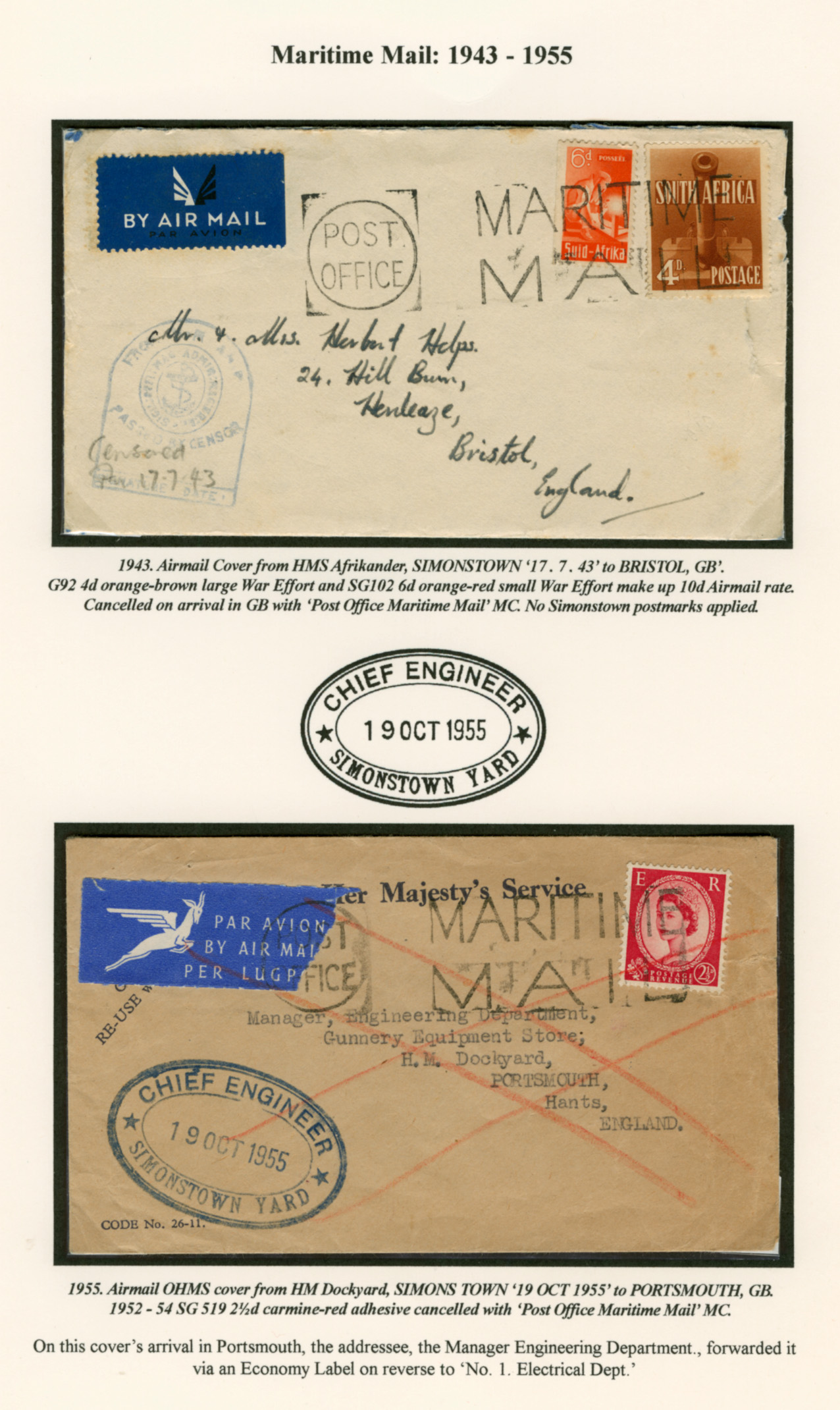
I attach the following cover because it is addressed to Stockport, a place dear to Jamie. It is also interesting for having been cancelled in Simonstown RN Base with BRITISH FLEET MAIL 29. It has travelled to the UK via the FMO and outside of any SAPO remit.
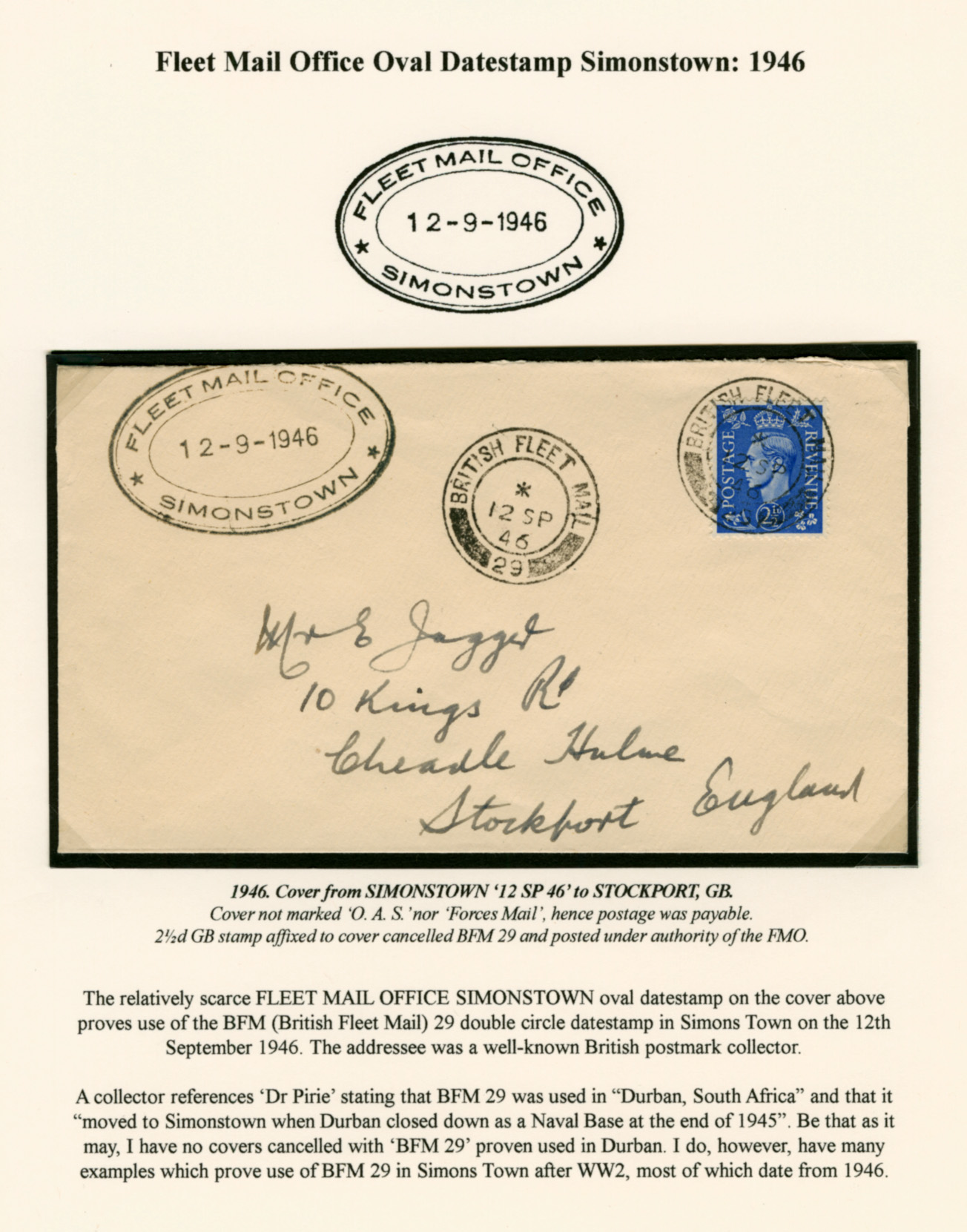
So, in summary, after the introduction of the FMO the RN had the ability to transport mail to the UK independently of SAPO. In some cases, mail was transported without first being cancelled in the RN base. This was cancelled on arrival in the UK, usually with the MARITIME MAIL machine canceller but also with Jamie's mystery MARITIME MAIL circular canceller. The delivery of FMO mail in SA will be discussed elesewhere.
Quote from Jamie Smith on July 16, 2025, 7:48 pmSimon's Town Cover.
Steve, I bow to your specialist knowledge and have re-written the offending cover. I confused myself by putting a date on the Maritime Mail cancellation as I had assumed that was the date that it was used.
All this goes to prove that we all need to show our material as we can only learn / teach each other when we do!
Simon's Town Cover.
Steve, I bow to your specialist knowledge and have re-written the offending cover. I confused myself by putting a date on the Maritime Mail cancellation as I had assumed that was the date that it was used.
All this goes to prove that we all need to show our material as we can only learn / teach each other when we do!
Uploaded files:

